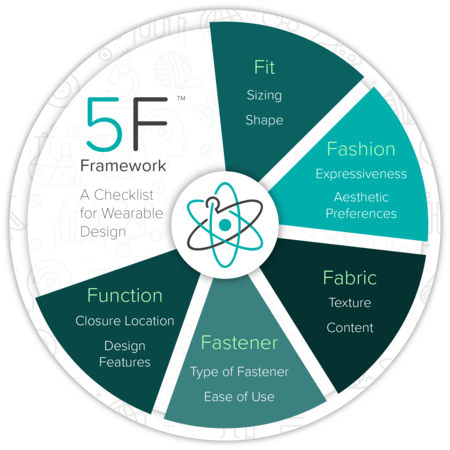My Design Process
I always start with a specific research approach and use a specific design framework: Design Thinking and the 5F™ Framework. The 5F framework is for “Wearable Design” and includes design considerations that must be addressed to serve the user’s needs. These are Fabric, Fasteners, Fit, Function, and Fashion.
- Fabric refers to the material selection that has the appropriate texture and performance properties to meet the user’s needs.
- Fasteners refers to the selection of closures that facilitate putting on and taking off the wearable and maximize user independence.
- Fit refers to the customization of the wearable to the specific size and shape of the user.
- Function refers to the purpose of the wearable and reflects the user’s physical, mental and/or psychosocial challenges.
- Fashion refers to the preferred style of the wearable that addresses the user’s aesthetic and expressive needs.
Each one of these areas represent choices in the design and construction of health wearables and each need to be answered, from the user’s perspective.
Lets take a deeper dive into each aspect of the framework.
Fabric

The consideration of materials, or “fabric” in the 5F’s, is the foundational building block for the design of health wearables. What are the performance metrics for the material? Does it need to be rigid, stretchy, or soft? Does it need to be smooth and silky against the skin? Does it need to compress the body or have moisture management properties?
Answering these questions are key to determining what fabric or additional materials are needed for the design. Wearables are most often associated with textiles. Textiles are created by weaving, knitting, or fusing together fibers. These fibers can be made from plant-based materials, such as cotton, or can be synthetic materials, such as polyester. The choice of fiber of based on what properties or characteristics are required for the design.
Other materials besides textiles for wearables can be metals, such as electronic components, plastics, which can be produced through 3D printing, or even ceramics, wood, and glass. The guiding principle is to select the appropriate material based on the desired performance metrics.
Fasteners

The consideration of fasteners is important to the security and size adjustment of the wearable and represents the 2nd “F” in the 5F Framework. Fasteners are the closure methods that make putting on and taking off the garment possible. Closures include buttons, zippers, hook & loop tape, and drawstrings, to name a few.
Closures can also have adjustable features to allow for the wearable to accommodate a variety of sizes, much in the same way that the hooks & eyes allow for on bra straps. The choice of fastener not only needs to adequately secure the wearable to the body, it also must align with the physical constraints of the user/patient.
My goal when selecting an appropriate fastener for a given project is, what are the physical characteristics of the user? Do they have limited range of motion or challenges with fine motor skills? Also, what are the practical implications? Will the user be wearing the device all day?
These are important questions to consider so that I may select a fastener that is stable and durable, but also easy for the user/patient to use. If I can select one that the patient can use without the assistance of a caregiver, all the better.
Fit

Within the 5F Framework, each “F” is treated with equal importance as a design consideration. However, if I was asked which “F” is of particular interest to me currently, I would say Fit. In general, fit is described in the research as “a complex issue and has been defined in divergent ways. Aspects of fit do not just involve the 3D body shape and the fabric properties which affect clothing drape and appearance, but also include a social message, fashion, body cathexis and…physical dimensions.”
Practically speaking, fit refers to the customization of the wearable to the specific size and shape of the user/patient. Historically however, there has been a major issue with fit for people with disabilities or any related challenge effecting body shape/size.
Wearable design has focused on a “typical” body, and what is considered a typical body changes over time and from culture to culture. For example. In the US in the 1920s petite women with thin, flat bodies were considered ideal, whereas in the 1950s, a more hourglass shape was considered attractive. What does not change, is that the typical body is normative and does not include any body that varies from that norm. It is for that reason that fit is so important to the design of health wearables, in order to be inclusive and accessible to ALL users.
Through the use of technology, such as 3D body scanners, we can take measurements with precision accuracy and truly create a custom fit wearable that suits the user/patient’s needs.
Function

Function refers to the purpose of the wearable and reflects the user’s physical, mental and/or psychosocial challenges. For the design of wearables to improve patient health outcomes, we think about the following functional criteria in the design process:
- Goal/metric: What is the functional goal for the wearable? What are we trying to achieve for the patient?
- Performance: How will the wearable perform in order to achieve the desired goal for the patient?
- Donning/Doffing: How will the patient get into and get out of the wearable?
- Ease of Use: Is the wearable something that is manageable, and preferably, easy to use for the patient and/or caregiver to use?
- Practicality: Is the wearable something that fits the current lifestyle and routine of the patient and/or caregiver?
Each of these questions need to be answered to the highest standard so that the wearable can serve its functional purpose in a way that aligns with the patient.
Fashion

Fashion refers to the preferred style of the wearable that addresses the user’s aesthetic and expressive needs. This is my favorite part of the 5Fs in part because of my fashion design background, but also because it is so rarely considered an important consideration. When I am working with team members from other disciplines, such as medicine or engineering, they often ask why should we care what the wearable looks like? Why would patients care? Aesthetics may not seem like an important consideration if the viewpoint is “let’s make it cute!”
Of course, that is going to seem silly, but what if we view aesthetics in a different way? Aesthetically pleasing devices communicate a high-quality, thoughtfully made product; a product that feels trustworthy and reliable to the end-user. For this reason, aesthetics facilitates patient compliance.
Another reason that aesthetics is important for wearables design is for personal expression of the patient. Again, this may seem like a frivolous concern, but personal expression is very important in today’s society. What we wear on our bodies communicates volumes to other people about who we are, and how we see ourselves.
Being able to choose what a wearable looks like gives the patient a sense of independence and dignity. They are choosing how they are seen by others, whether that be highlighting their differences or disguising it. Either way, it should be up to the patient to decide.
In the design of wearables for health, we may be inadvertently stigmatizing the patient to feel (dis)abled or to feel “less than” their typical peers. By inserting fashion into the design framework, we treat the patient as any other consumer would be treated: one with dignity and respect.
Looking Forward
This framework drives every project I work on and every direction they take. It helps me ensure that the needs of the user are taken into account holistically, from a position of empathy.
I hope you’ve enjoyed reading this blog and learning about the 5F framework. If you’d like to learn more about my work and wearable technology, subscribe to my blog.

